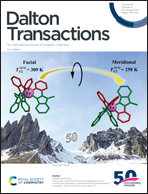A two-year water-stable 2D MOF with aqueous NIR photothermal conversion ability†
Abstract
Structural lability in humid air or water severely limits the practical use of MOFs. Developing new MOFs with exceptional water stability is interesting for both industrial applications and academic research. Herein we report a new method to improve the water stability of MOFs by using three-dimensional rigid shielding ligands. A very highly stable two-dimensional MOF (CuCP-MOF) is synthesized in this work, in which [2,2]paracyclophane dicarboxylate ligands are coordinated with Cu(II) ions to form a paddle wheel structure. CuCP-MOF is a triclinic crystal with unit cell parameters a = 10.065 Å, b = 10.897 Å, c = 10.940 Å, α = 90.676°, β = 91.729°, and γ = 92.725° determined by single crystal X-ray diffraction and DFT simulation. It can easily form MOF nanosheets due to the large interlayer distance and weak interlayer interactions. It shows good aqueous stability, and remains intact after storage in water for two years, as evidenced by FTIR and XRD analyses. CuCP-MOF shows a strong absorption in the NIR range due to the d–d transition of Cu(II). The aqueous dispersions of CuCP-MOF exhibit high NIR photothermal conversion efficiency, about 17.5% for a laser with an energy density of 5 W cm−2 (808 nm) and 22.0% for a laser of 2 W cm−2 on average.



 Please wait while we load your content...
Please wait while we load your content...